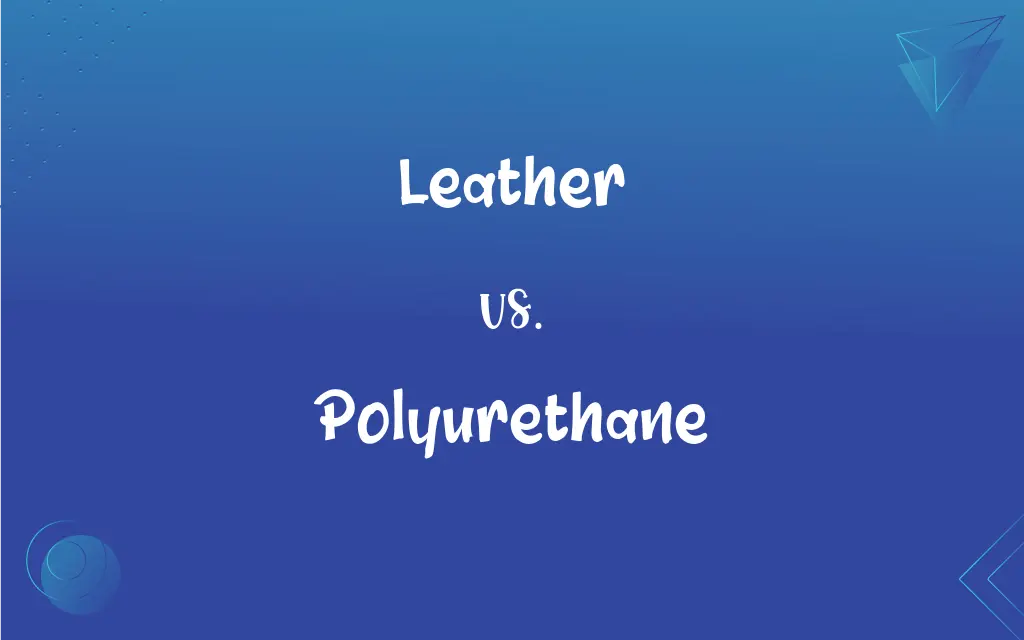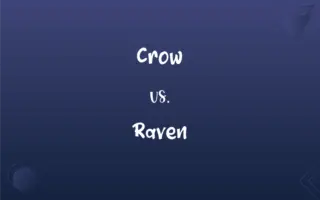Leather vs. Polyurethane: What's the Difference?
Edited by Janet White || By Harlon Moss || Updated on October 21, 2023
Leather is a natural material made from animal hides, while polyurethane is a synthetic plastic polymer.

Key Differences
Leather is a timeless material derived from the processed hides of animals, primarily from cows. Renowned for its durability, flexibility, and appearance, leather has been used for millennia in apparel, accessories, and upholstery. The natural grains and imperfections in leather lend each piece a unique aesthetic, making it a sought-after material for luxury goods.
Polyurethane, on the other hand, is a versatile synthetic polymer. Often used as a substitute for leather, polyurethane can be manufactured to mimic the texture and appearance of genuine leather, but without using animal products. As a plastic compound, polyurethane can be tailored for various levels of softness, resilience, and finish, making it adaptable for numerous applications beyond just faux leather products.
The production methods of leather and polyurethane are starkly different. While leather involves the tanning and treatment of animal hides, polyurethane is produced through chemical reactions involving organic units and isocyanates. This fundamental distinction in origin and production often translates to differences in product care, lifespan, and ecological impact.
From an environmental standpoint, leather raises concerns about the use of chemicals in tanning processes and the ethics of using animal products. Polyurethane, being petroleum-based, comes with its set of environmental challenges, notably its non-biodegradability and the environmental footprint associated with plastic production.
In the market, products made of leather generally command higher prices due to their natural origin and the meticulous processes involved in its preparation. Polyurethane products, being synthetically produced, can be more affordable but may not offer the same longevity or tactile richness as genuine leather items.
ADVERTISEMENT
Comparison Chart
Origin
Processed animal hides
Synthetic plastic polymer
Appearance
Unique grains and natural textures
Can mimic leather's appearance
Production Process
Tanning and treatment of hides
Chemical reactions involving organic units
Environmental Impact
Chemical use in tanning, animal ethics
Non-biodegradable, petroleum-based
Typical Use
Apparel, accessories, upholstery
Faux leather, foams, sealants, coatings
ADVERTISEMENT
Leather and Polyurethane Definitions
Leather
Leather is a material produced by tanning animal hides.
The leather jacket became a symbol of rebellious style in the 1950s.
Polyurethane
Polyurethane is a synthetic polymer with diverse applications.
The polyurethane coating on the table made it more resistant to scratches.
Leather
Leather is a durable and flexible material used in various products.
A leather-bound book gives a classic and sophisticated touch.
Polyurethane
Polyurethane can be flexible or rigid based on its formulation.
Flexible polyurethane foam is commonly used in upholstery.
Leather
Leather products age gracefully, often developing a patina over time.
His leather wallet developed a rich patina after years of use.
Polyurethane
Polyurethane is often used as a faux leather material.
Vegans may opt for polyurethane leather jackets as an animal-friendly choice.
Leather
Leather is known for its natural texture and unique grain patterns.
High-quality leather handbags often showcase the material's beautiful natural grain.
Polyurethane
Polyurethane is a versatile material found in sealants, adhesives, and coatings.
The polyurethane sealant provided a waterproof barrier in the bathroom.
Leather
Leather is a breathable material, making it comfortable for wear.
Leather shoes provide comfort by allowing feet to breathe.
Polyurethane
Polyurethane is a petroleum-based plastic known for its durability.
The polyurethane wheels on the skateboard allowed for smoother rides.
Leather
The dressed or tanned hide of an animal.
Polyurethane
Any of various thermoplastic isocyanate polymers, widely varying in flexibility, used in tough chemical-resistant coatings, adhesives, and foams.
Polyurethane
(organic chemistry) Any of various polymeric resins containing urethane links; used in very many industrial and domestic applications.
Polyurethane
Any polymer containing [-NH.CO.O-] linkages; such polymers are much used as the basis of light but rigid foams for packaging (polyurethane foam) and for hard coatings, as on floors.
Polyurethane
Any of various polymers containing the urethane radical; a wide variety of synthetic forms are made and used as adhesives or plastics or paints or rubber
FAQs
Is polyurethane an animal-friendly alternative to leather?
Yes, polyurethane is often used as an animal-friendly alternative to leather.
How environmentally friendly is polyurethane?
Polyurethane is petroleum-based and non-biodegradable, posing some environmental concerns.
Are there different types of polyurethane?
Yes, polyurethane can be formulated to be flexible or rigid, and it has various types based on its chemical composition.
Can leather be waterproofed?
While leather has natural water-resistant properties, it can be treated further to enhance its waterproofing.
How long has leather been in use?
Leather has been used for thousands of years across various cultures.
How is leather treated to become a usable product?
Leather is treated through a process called tanning, which stabilizes the proteins in the hide.
Why is leather considered a luxury material?
Leather's natural texture, durability, and unique grain patterns make it sought-after for luxury goods.
What are common products made from polyurethane?
Common products include faux leather items, mattresses, sealants, and protective coatings.
Is polyurethane breathable like leather?
Polyurethane is generally less breathable than leather, though formulations can vary.
What are the care recommendations for leather products?
Leather should be kept away from prolonged moisture, cleaned with suitable products, and conditioned to maintain its luster.
Is leather biodegradable?
Yes, as a natural material, leather is biodegradable, though the tanning process can affect its decomposition rate.
What is leather made from?
Leather is made from the processed hides of animals, primarily cows.
How does leather age over time?
Leather often develops a patina, becoming richer and more textured with age.
Can leather be dyed in different colors?
Yes, leather can be dyed in a wide range of colors during the tanning process.
What is polyurethane primarily used for?
Polyurethane is used for a range of applications, including faux leather, foams, sealants, and coatings.
How is polyurethane produced?
Polyurethane is produced through chemical reactions involving organic units and isocyanates.
Are there alternatives to polyurethane for faux leather?
Yes, other faux leather materials include PVC (polyvinyl chloride) and bio-based alternatives.
Is polyurethane resistant to wear and tear?
Polyurethane is known for its durability and resistance to wear, though it might not have the same resilience as genuine leather over time.
How durable is polyurethane when used as faux leather?
While polyurethane is durable, it may not offer the same longevity as genuine leather.
Do leather products always come from cowhide?
No, while cowhide is common, leather can also be derived from pigs, goats, sheep, and exotic animals.
About Author
Written by
Harlon MossHarlon is a seasoned quality moderator and accomplished content writer for Difference Wiki. An alumnus of the prestigious University of California, he earned his degree in Computer Science. Leveraging his academic background, Harlon brings a meticulous and informed perspective to his work, ensuring content accuracy and excellence.
Edited by
Janet WhiteJanet White has been an esteemed writer and blogger for Difference Wiki. Holding a Master's degree in Science and Medical Journalism from the prestigious Boston University, she has consistently demonstrated her expertise and passion for her field. When she's not immersed in her work, Janet relishes her time exercising, delving into a good book, and cherishing moments with friends and family.































































